Electrical wiring in general refers to insulated conductors used to carry electricity, and associated devices. This article describes general aspects of electrical wiring as used to provide power in buildings and structures, commonly referred to as building wiring. This article is intended to describe common features of electrical wiring that may apply worldwide. For information regarding specific national electrical codes, refer to the articles mentioned in the next section. Separate articles cover long-distance electric power transmission and electric power distribution. 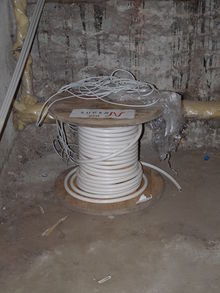 Three-phase copper cable TN-S 16 mm2 with PVC insulation Contents 1 Wiring safety codes 2 Color code 3 Wiring methods 3.1 Early wiring methods 3.2 Knob and tube 3.3 Metal-sheathed wires 3.4 Other historical wiring methods 4 Cables 4.1 Copper conductors 4.2 Aluminium conductors 4.3 Modern wiring materials 5 Raceways 6 Bus bars, bus duct, cable bus 7 Electrical panels 8 See also 9 References 10 Bibliography 11 Further reading 12 External links Wiring safety codes 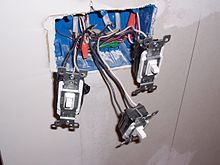
Typical North American wiring to 3 wall switches Wiring safety codes are intended to protect people and property from electrical shock and fire hazards. Regulations may be established by city, county, provincial/state or national legislation, usually by adopting a model code (with or without local amendments) produced by a technical standards-setting organization, or by a national standard electrical code. Electrical codes arose in the 1880s with the commercial introduction of electrical power. Many conflicting standards existed for the selection of wire sizes and other design rules for electrical installations. The first electrical codes in the United States originated in New York in 1881 to regulate installations of electric lighting. Since 1897 the US National Fire Protection Association, a private non-profit association formed by insurance companies, has published the National Electrical Code (NEC). States, counties or cities often include the NEC in their local building codes by reference along with local differences. The NEC is modified every three years. It is a consensus code considering suggestions from interested parties. The proposals are studied by committees of engineers, tradesmen, manufacturer representatives, fire fighters, and other invitees. Since 1927, the Canadian Standards Association (CSA) has produced the Canadian Safety Standard for Electrical Installations, which is the basis for provincial electrical codes. The CSA also produces the Canadian Electrical Code, the 2006 edition of which references IEC 60364 (Electrical Installations for Buildings) and states that the code addresses the fundamental principles of electrical protection in Section 131. The Canadian code reprints Chapter 13 of IEC 60364, but there are no numerical criteria listed in that chapter to assess the adequacy of any electrical installation. Although the US and Canadian national standards deal with the same physical phenomena and broadly similar objectives, they differ occasionally in technical detail. As part of the North American Free Trade Agreement (NAFTA) program, US and Canadian standards are slowly converging toward each other, in a process known as harmonization. In European countries, an attempt has been made to harmonize national wiring standards in an IEC standard, IEC 60364 Electrical Installations for Buildings. Hence national standards follow an identical system of sections and chapters. However, this standard is not written in such language that it can readily be adopted as a national wiring code. Neither is it designed for field use by electrical tradesmen and inspectors for testing compliance with national wiring standards. By contrast, national codes, such as the NEC or CSA C22.1, generally exemplify the common objectives of IEC 60364, but provide specific rules in a form that allows for guidance of those installing and inspecting electrical systems. In Germany, DKE (the German Commission for Electrical, Electronic and Information Technologies of DIN and VDE) is the organisation responsible for the promulgation of electrical standards and safety specifications. DIN VDE 0100 is the German wiring regulations document harmonised with IEC 60364. In the United Kingdom, wiring installations are regulated by the Institution of Engineering and Technology Requirements for Electrical Installations: IEE Wiring Regulations, BS 7671: 2008, which are harmonised with IEC 60364. The 17th edition (issued in January 2008) includes new sections for microgeneration and solar photovoltaic systems. The first edition was published in 1882. In Australia and New Zealand, the AS/NZS 3000 standard, commonly known as the "wiring rules", specifies requirements for the selection and installation of electrical equipment, and the design and testing of such installations. The standard is mandatory in both New Zealand and Australia; therefore, all electrical work covered by the standard must comply. The international standard wire sizes are given in the IEC 60228 standard of the International Electrotechnical Commission. In North America, the American Wire Gauge standard for wire sizes is used. Color code To enable wires to be easily and safely identified, all common wiring safety codes mandate a colour scheme for the insulation on power conductors. In a typical electrical code, some colour coding is mandatory, while some may be optional. Many local rules and exceptions exist. Older installations vary in colour codes, and colours may shift with insulation exposure to heat, light, and ageing. Many electrical codes now recognize (or even require) the use of wire covered with green insulation, additionally marked with a prominent yellow stripe, for safety grounding (earthing) connections. This growing international standard was adopted for its distinctive appearance, to reduce the likelihood of dangerous confusion of safety grounding wires with other electrical functions, especially by persons affected by red-green colour blindness. 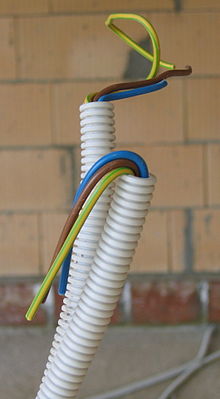
An electrical "3G" power cable found commonly in modern European houses. The cable consists of 3 wires (2 wires + 1 grounding in case if cable has "3G" name) and is double-insulated. Diagram of typical green/yellow colour-coded wire for grounding (earthing).
Wiring methods Materials for wiring interior electrical systems in buildings vary depending on: Intended use and amount of power demand on the circuit Type of occupancy and size of the building National and local regulations Environment in which the wiring must operate. Wiring systems in a single family home or duplex, for example, are simple, with relatively low power requirements, infrequent changes to the building structure and layout, usually with dry, moderate temperature, and non-corrosive environmental conditions. In a light commercial environment, more frequent wiring changes can be expected, large apparatus may be installed, and special conditions of heat or moisture may apply. Heavy industries have more demanding wiring requirements, such as very large currents and higher voltages, frequent changes of equipment layout, corrosive, or wet or explosive atmospheres. In facilities that handle flammable gases or liquids, special rules may govern the installation and wiring of electrical equipment in hazardous areas. Wires and cables are rated by the circuit voltage, temperature rating, and environmental conditions (moisture, sunlight, oil, chemicals) in which they can be used. A wire or cable has a voltage (to neutral) rating, and a maximum conductor surface temperature rating. The amount of current a cable or wire can safely carry depends on the installation conditions. 220px-Installing_electrical_wiring.JPG Installing electrical wiring by cutting into the bricks of the building Early wiring methods The first interior power wiring systems used conductors that were bare or covered with cloth, which were secured by staples to the framing of the building or on running boards. Where conductors went through walls, they were protected with cloth tape. Splices were done similarly to telegraph connections, and soldered for security. Underground conductors were insulated with wrappings of cloth tape soaked in pitch, and laid in wooden troughs which were then buried. Such wiring systems were unsatisfactory because of the danger of electrocution and fire, plus the high labour cost for such installations. Knob and tube The earliest standardized method of wiring in buildings, in common use in North America from about 1880 to the 1930s, was knob and tube (K&T) wiring: single conductors were run through cavities between the structural members in walls and ceilings, with ceramic tubes forming protective channels through joists and ceramic knobs attached to the structural members to provide air between the wire and the lumber and to support the wires. Since air was free to circulate over the wires, smaller conductors could be used than required in cables. By arranging wires on opposite sides of building structural members, some protection was afforded against short-circuits that can be caused by driving a nail into both conductors simultaneously. By the 1940s, the labour cost of installing two conductors rather than one cable resulted in a decline in new knob-and-tube installations. However, the US code still allows new K&T wiring installations in special situations (some rural and industrial applications). Knob-and-Tube wiring Metal-sheathed wires In the United Kingdom, an early form of insulated cable,[1] introduced in 1896, consisted of two impregnated-paper-insulated conductors in an overall lead sheath. Joints were soldered, and special fittings were used for lamp holders and switches. These cables were similar to underground telegraph and telephone cables of the time. Paper-insulated cables proved unsuitable for interior wiring installations because very careful workmanship was required on the lead sheaths to ensure moisture did not affect the insulation. A system later invented in the UK in 1908 employed vulcanized-rubber insulated wire enclosed in a strip metal sheath. The metal sheath was bonded to each metal wiring device to ensure earthing continuity. A system developed in Germany called "Kuhlo wire" used one, two, or three rubber-insulated wires in a brass or lead-coated iron sheet tube, with a crimped seam. The enclosure could also be used as a return conductor. Kuhlo wire could be run exposed on surfaces and painted, or embedded in plaster. Special outlet and junction boxes were made for lamps and switches, made either of porcelain or sheet steel. The crimped seam was not considered as watertight as the Stannos wire used in England, which had a soldered sheath.[2] A somewhat similar system called "concentric wiring" was introduced in the United States around 1905. In this system, an insulated electrical wire was wrapped with copper tape which was then soldered, forming the grounded (return) conductor of the wiring system. The bare metal sheath, at earth potential, was considered safe to touch. While companies such as General Electric manufactured fittings for the system, and a few buildings were wired with it, it was never adopted into the US National Electrical Code. Drawbacks of the system were that special fittings were required, and that any defect in the connection of the sheath would result in the sheath becoming energized. Other historical wiring methods Other methods of securing wiring that are now obsolete include: Re-use of existing gas pipes when converting gas light installations to electric lighting. Insulated conductors were pulled into the pipes formerly feeding the gas lamps. Although used occasionally, this method risked insulation damage from sharp edges inside the pipe at each joint. Wood mouldings with grooves cut for single conductor wires, covered by a wooden cap strip. These were prohibited in North American electrical codes by 1928. Wooden moulding was also used to some degree in England, but was never permitted by German and Austrian rules. A system of flexible twin cords supported by glass or porcelain buttons was used near the turn of the 20th century in Europe, but was soon replaced by other methods. During the first years of the 20th century, various patented forms of wiring system such as Bergman and Peschel tubing were used to protect wiring; these used very thin fiber tubes, or metal tubes which were also used as return conductors. In Austria, wires were concealed by embedding a rubber tube in a groove in the wall, plastering over it and then removing the tube and pulling in wires in the cavity. Metal moulding systems, with a flattened oval section consisting of a base strip and a snap-on cap channel, were more costly than open wiring or wooden moulding, but could be easily run on wall surfaces. Similar surface mounted raceway wiring systems are still available today. Cables 
Wiring for extremely wet conditions Armoured cables with two rubber-insulated conductors in a flexible metal sheath were used as early as 1906, and were considered at the time a better method than open knob-and-tube wiring, although much more expensive. The first polymer-insulated cables for building wiring were introduced in 1922. These were two or more solid copper electrical wires with rubber insulation, plus woven cotton cloth over each conductor for protection of the insulation, with an overall woven jacket, usually impregnated with tar as a protection from moisture. Waxed paper was used as a filler and separator. Over time, rubber-insulated cables become brittle because of exposure to atmospheric oxygen, so they must be handled with care, and are usually replaced during renovations. When switches, outlets or light fixtures are replaced, the mere act of tightening connections may cause hardened insulation to flake off the conductors. Rubber insulation further inside the cable often is in better condition than the insulation exposed at connections, due to reduced exposure to oxygen. Rubber insulation was hard to strip from bare copper, so copper was tinned, causing slightly more electrical resistance. Rubber insulation is no longer used for permanent wiring installations, but may still be used for replaceable temporary cables where flexibility is important, such as electrical extension cords. About 1950, PVC insulation and jackets were introduced, especially for residential wiring. About the same time, single conductors with a thinner PVC insulation and a thin nylon jacket (e.g. US Type THN, THHN, etc.) became common. The simplest form of cable has two insulated conductors twisted together to form a unit; such unjacketed cables with two or three conductors are used for low-voltage signal and control applications such as doorbell wiring. In North American practice, an overhead cable from a transformer on a power pole to a residential electrical service consists of three twisted (triplexed) wires, often with one being a bare wire made of copper (protective earth/ground) and the other two being insulated for the line voltage (hot/live wire and neutral wire). For additional safety, the ground wire may be formed into a stranded co-axial layer completely surrounding the phase conductors, so that the outmost conductor is grounded. Copper conductors Electrical devices often contain copper conductors because of their multiple beneficial properties, including their high electrical conductivity, tensile strength, ductility, creep resistance, corrosion resistance, thermal conductivity, coefficient of thermal expansion, solderability, resistance to electrical overloads, compatibility with electrical insulators, and ease of installation. Despite competition from other materials, copper remains the preferred electrical conductor in nearly all categories of electrical wiring.[8][9] For example, copper is used to conduct electricity in high, medium and low voltage power networks, including power generation, power transmission, power distribution, telecommunications, electronics circuitry, data processing, instrumentation, appliances, entertainment systems, motors, transformers, heavy industrial machinery, and countless other types of electrical equipment. Aluminium conductors 220px-Transistive_terminals_for_AL-CU_junction.jpg" height="200" width="200"> Terminal blocks for joining aluminium and copper conductors. The terminal blocks may be mounted on a DIN rail. Aluminium wire was common in North American residential wiring from the late 1960s to mid 1970s due to the rising cost of copper. Because of its greater resistivity, aluminium wiring requires larger conductors than copper. For instance, instead of 14 AWG (American wire gauge) for most lighting circuits, aluminium wiring would be 12 AWG on a typical 15 ampere circuit, though local building codes may vary. Aluminium conductors were originally indiscriminately used with wiring devices intended for copper conductors. This practice was found to cause defective connections unless the aluminium was one of a special alloy, or all devices — breakers, switches, receptacles, splice connectors, wire nuts, etc. — were specially designed for the purpose. These special designs address problems with junctions between dissimilar metals, oxidation on metal surfaces, and mechanical effects that occur as different metals expand at different rates with increases in temperature. Unlike copper, aluminium has a tendency to cold-flow under pressure, so screw clamped connections may get loose over time. This can be mitigated by using spring-loaded connectors that apply constant pressure, applying high pressure cold joints in splices and termination fittings, and torquing the bolted connection.[further explanation needed] Also unlike copper, aluminium forms an insulating oxide layer on the surface. This is sometimes addressed by coating aluminium wires with an antioxidant paste at joints, or by applying a mechanical termination designed to break through the oxide layer during installation. Because of improper design and installation, some junctions to wiring devices would overheat under heavy current load, and cause fires. Revised standards for wiring devices (such as the CO/ALR "copper-aluminium-revised" designation) were developed to reduce these problems. Nonetheless, aluminium wiring for residential use has acquired a poor reputation and has fallen out of favour. Aluminium conductors are still used for bulk power distribution and large feeder circuits, because they cost less than copper wiring, and weigh less, especially in the large sizes needed for heavy current loads. Aluminium conductors must be installed with compatible connectors. Modern wiring materials Modern non-metallic sheathed cables, such as (US and Canadian) Type NMB and NMC, consist of two to four wires covered with thermoplastic insulation and a bare wire for grounding (bonding) surrounded by a flexible plastic jacket. Some versions wrap the individual conductors in paper before the plastic jacket is applied. It is often called Romex cable, since the first of its type was manufactured by Rome Cable Division of Cyprus Mines, Rome, New York. The trade name has been owned by Southwire since it purchased the electrical building wire assets of General Cable in 2001. Special versions of non-metallic sheathed cables, such as US Type UF, are designed for direct underground burial (often with separate mechanical protection) or exterior use where exposure to ultraviolet radiation (UV) is a possibility. These cables differ in having a moisture-resistant construction, lacking paper or other absorbent fillers, and being formulated for UV resistance. Rubber-like synthetic polymer insulation is used in industrial cables and power cables installed underground because of its superior moisture resistance. Insulated cables are rated by their allowable operating voltage and their maximum operating temperature at the conductor surface. A cable may carry multiple usage ratings for applications, for example, one rating for dry installations and another when exposed to moisture or oil. Generally, single conductor building wire in small sizes is solid wire, since the wiring is not required to be very flexible. Building wire conductors larger than 10 AWG (or about 6 mm²) are stranded for flexibility during installation, but not stranded enough to be flexible enough to use as appliance cord. Cables for industrial, commercial, and apartment buildings may contain many insulated conductors in an overall jacket, with helical tape steel or aluminium armour, or steel wire armour, and perhaps as well an overall PVC or lead jacket for protection from moisture and physical damage. Cables intended for very flexible service or in marine applications may be protected by woven bronze wires. Power or communications cables (e.g., computer networking) that are routed in or through air-handling spaces (plenums) of office buildings are required under the model code to be either encased in metal conduit or rated for low flame and smoke production. 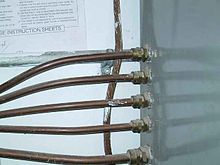 Mineral insulated cables at a panel board For some industrial uses in steel mills and similar hot environments, no organic material gives satisfactory service. Cables insulated with compressed mica flakes are sometimes used. Another form of high-temperature cable is a mineral insulated cable, with individual conductors placed within a copper tube, and the space filled with magnesium oxide powder. The whole assembly is drawn down to smaller sizes, thereby compressing the powder. Such cables have a certified fire resistance rating, are more costly than non-fire rated cable, and have little flexibility and are effectively rigid to the user of the cable. Because multiple conductors bundled in a cable cannot dissipate heat as easily as single insulated conductors, those circuits are always rated at a lower "ampacity". Tables in electrical safety codes give the maximum allowable current for a particular size of conductor, for the voltage and temperature rating at the surface of the conductor for a given physical environment, including the insulation type and thickness. The allowable current will be different for wet or dry, for hot (attic) or cool (underground) locations. In a run of cable through several areas, the most severe area will determine the appropriate rating of the overall run. Cables usually are secured by special fittings where they enter electrical apparatus; this may be a simple screw clamp for jacketed cables in a dry location, or a polymer-gasketed cable connector that mechanically engages the armour of an armoured cable and provides a water-resistant connection. Special cable fittings may be applied to prevent explosive gases from flowing in the interior of jacketed cables, where the cable passes through areas where inflammable gases are present. To prevent loosening of the connections of individual conductors of a cable, cables must be supported near their entrance to devices and at regular intervals through their length. In tall buildings special designs are required to support the conductors of vertical runs of cable. Usually, only one cable per fitting is allowed unless the fitting is otherwise rated. Special cable constructions and termination techniques are required for cables installed in ocean-going vessels; in addition to electrical safety and fire safety, such cables may also be required to be pressure-resistant where they penetrate bulkheads of a ship. Raceways Insulated wires may be run in one of several forms of a raceway between electrical devices. This may be a specialized bendable pipe, called a conduit, or one of several varieties of metal (rigid steel or aluminium) or non-metallic (PVC or HDPE) tubing. Rectangular cross-section metal or PVC wire troughs (North America) or trunking (UK) may be used if many circuits are required. Wires run underground may be run in plastic tubing encased in concrete, but metal elbows may be used in severe pulls. Wiring in exposed areas, for example factory floors, may be run in cable trays or rectangular raceways having lids. Where wiring, or raceways that hold the wiring, must traverse fire-resistance rated walls and floors, the openings are required by local building codes to be firestopped. In cases where safety-critical wiring must be kept operational during an accidental fire, fireproofing must be applied to maintain circuit integrity in a manner to comply with a product's certification listing. The nature and thickness of any passive fire protection materials used in conjunction with wiring and raceways has a quantifiable impact upon the ampacity derating, because the thermal insulation properties needed for fire resistance also inhibit air cooling of power conductors. Cable trays are used in industrial areas where many insulated cables are run together. Individual cables can exit the tray at any point, simplifying the wiring installation and reducing the labour cost for installing new cables. Power cables may have fittings in the tray to maintain clearance between the conductors, but small control wiring is often installed without any intentional spacing between cables. Since wires run in conduits or underground cannot dissipate heat as easily as in open air, and since adjacent circuits contribute induced currents, wiring regulations give rules to establish the current capacity (ampacity). Special sealed fittings are used for wiring routed through potentially explosive atmospheres. Bus bars, bus duct, cable bus For very heavy currents in electrical apparatus, and for heavy currents distributed through a building, bus bars can be used. Each live conductor of such a system is a rigid piece of copper or aluminium, usually in flat bars (but sometimes as tubing or other shapes). Open bus bars are never used in publicly accessible areas, although they are used in manufacturing plants and power company switch yards to gain the benefit of air cooling. A variation is to use heavy cables, especially where it is desirable to transpose or "roll" phases. In industrial applications, conductor bars are often pre-assembled with insulators in grounded enclosures. This assembly, known as bus duct or busway, can be used for connections to large switchgear or for bringing the main power feed into a building. A form of bus duct known as "plug-in bus" is used to distribute power down the length of a building; it is constructed to allow tap-off switches or motor controllers to be installed at designated places along the bus. The big advantage of this scheme is the ability to remove or add a branch circuit without removing voltage from the whole duct. Bus ducts may have all phase conductors in the same enclosure (non-isolated bus), or may have each conductor separated by a grounded barrier from the adjacent phases (segregated bus). For conducting large currents between devices, a cable bus is used.[further explanation needed] For very large currents in generating stations or substations, where it is difficult to provide circuit protection, an isolated-phase bus is used. Each phase of the circuit is run in a separate grounded metal enclosure. The only fault possible is a phase-to-ground fault, since the enclosures are separated. This type of bus can be rated up to 50,000 amperes and up to hundreds of kilovolts (during normal service, not just for faults), but is not used for building wiring in the conventional sense. Electrical panels Electrical panels, cables and firestops in an electrical service room at St. Mary's Pulp and Paper, a paper mill in Sault Ste. Marie, Ontario, Canada. Electrical panels are easily accessible junction boxes used to reroute and switch electrical services. The term is often used to refer to circuit breaker panels or "fuseboxes". 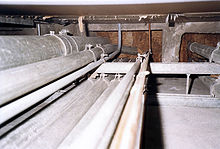 Electrical Conduit risers, seen inside fire-resistance rated shaft, as seen entering bottom of a firestop. The firestop is made of firestop mortar on top, rockwool on the bottom. Raceways are used to protect cables from damage. 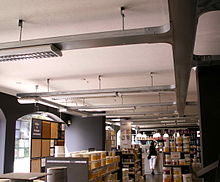 A cable tray can be used in stores and dwellings 220px-Conduit_busduct.jpg" height="200" width="200"> Topside of firestop with penetrants consisting of electrical conduit on the left and a bus duct on the right. The firestop consists of firestop mortar on top and rockwool on the bottom, for a 2 hour fire-resistance rating. 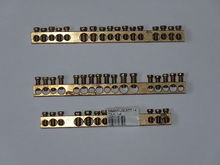
Busbars for distributing PE (ground) 220px-Electrical_panels_st_marys.jpglectrical panels, cables and firestops in an electrical service room at St. Mary's Pulp and Paper, a paper mill in Sault Ste. Marie, Ontario, North America. See also 10603 — a frequently used MIL-SPEC compliant wire Cable Cable tray Domestic AC power plugs and sockets Electrical conduit Electrical room Electrical wiring in North America Electrical wiring in the United Kingdom Electricity distribution Grounding Home wiring Industrial and multiphase power plugs and sockets M13486 — MIL-SPEC compliant wire Neutral wire OFHC Portable cord Restriction of Hazardous Substances Directive (RoHS) Single-phase electric power Structured cabling Three-phase electric power Unusual and obsolete plugs and sockets | ||||||||||||||||||||||||||||||||||||||||||||||||||||||||||||||||||||
